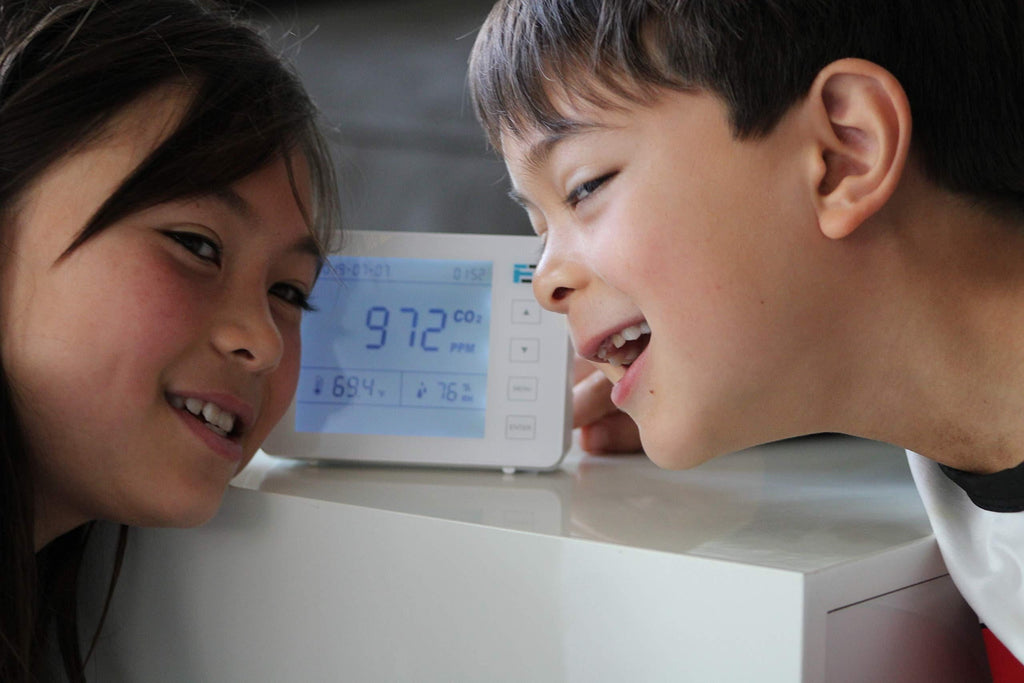Gas detection is crucial when it comes to distinguishing between carbon dioxide (CO2) and carbon monoxide (CO), two gases that are often erroneously confused. Even professional get confused. See the video here to see a Fire Chief on national TV refer to carbon monoxide gas as CO2. Each gas possesses unique properties and has different implications for human health, making accurate detection and understanding of these disparities essential. CO2 detection is vital for monitoring indoor air quality, as elevated levels can indicate poor ventilation and potential health risks. On the other hand, CO detection is critical for preventing poisoning from this odorless, colorless, and toxic gas. Gas detection technologies for CO2 and CO differ, with CO2 detectors often using infrared sensors, while CO detectors employ electrochemical or metal oxide semiconductor sensors. Understanding the differences between these gases and their respective detection methods is crucial for ensuring safety and making informed decisions in our daily lives.
Pros |
Cons |
|
✅ Carbon Dioxide is not as toxic as Carbon Monoxide. ✅ Carbon Dioxide occurs naturally ✅ Carbon Dioxide and Carbon Monoxide are both produced during combustion. ✅ CO2 and CO detectors are available for personal safety and protection from harm. |
⛔ Carbon Monoxide does not occur naturally ⛔ Carbon Dioxide and Carbon Monoxide are both produced during combustion. ⛔ Carbon Dioxide and Carbon Monoxide are both toxic gases and too much of each can poison and harm humans. |
Carbon dioxide is a gas, often denoted as CO2, is a naturally occurring gas that saturates the air we breathe, whether we are indoors or outdoors.
This is the first difference between Carbon Monoxide and Carbon Dioxide, that they also have different chemical symbols. CO versus CO2.
Differences between Carbon Monoxide and Carbon Dioxide?
Carbon Dioxide in our Breath?
Carbon dioxide is a byproduct of our breathing, as we expel substantial amounts of it when we exhale. In the natural environment (outdoors), carbon dioxide levels typically hover between 400 to 500 parts per million (PPM).
Carbon Dioxide Exhalation to Bad Air Quality?
When we exhale in closed environments such as our home, work, office, and school classrooms, our exhaled carbon dioxide can lead to poor indoor air quality. Our exhalations release larger quantities of carbon dioxide (2-3% of CO2) into these enclosed areas, thus increasing its concentration by mixing with lower levels in the room and accumulating over time. This underscores the vital importance of ensuring a continuous inflow of fresh air into indoor environments, be it at our workplaces or within the cozy confines of our homes. This influx serves as a countermeasure to the accumulating effects of exhalation, a pivotal aspect of maintaining indoor air quality.
Also we have a specific article discussed where to install your carbon monoxide detector.
Carbon Dioxide Monitoring Indoors?
Monitoring carbon dioxide levels within indoor spaces becomes of utmost significance. To illustrate, I have a handheld carbon dioxide monitor with me, capable of detecting ambient carbon dioxide levels. Currently, the reading hovers around 600 to 700 PPM (in the indoor space I am within). However, as I bring the device closer to my mouth, it registers a notable increase in carbon dioxide levels, eventually triggering an alarm set at 1,000 PPM. This vividly showcases how the simple act of breathing, especially in enclosed spaces, can lead to elevated carbon dioxide levels, underscoring the need for adequate ventilation.
Elevated Levels of Carbon Dioxide?
Elevated concentrations of carbon dioxide can have adverse effects on our well-being, inducing feelings of fatigue and nausea while impeding our ability to concentrate effectively. Numerous academic studies have illuminated the detrimental impact of high carbon dioxide levels on cognitive function. This highlights the significance of maintaining good air quality, especially in educational institutions, such as high schools, middle schools, and elementary schools. Ensuring optimal air quality is paramount to creating an environment where students can concentrate and excel in their studies.
Now, let's explore a common question – the differentiation between carbon monoxide and carbon dioxide. Carbon monoxide, abbreviated as CO, is an exceedingly toxic gas. Exposure to 1,000 PPM of carbon monoxide can be fatal. In contrast, carbon dioxide, represented as CO2, is not lethal at similar concentrations, as we have demonstrated earlier. While both gases share certain traits, such as their nearly imperceptible odor and taste, they emanate from combustion sources, leading to occasional confusion between carbon monoxide and carbon dioxide.
Toxicity of Carbon Dioxide compared to Carbon Monoxide?
Carbon monoxide (CO) and carbon dioxide (CO2) are both colorless, odorless gases, but they have different toxic effects. CO binds to hemoglobin, reducing oxygen transport, leading to oxygen deprivation, dizziness, and potentially death. CO2, in contrast, primarily causes toxicity by increasing acidity in the blood, resulting in symptoms like confusion and rapid breathing, though it is less immediately life-threatening. Both gases are dangerous in high concentrations, but their mechanisms and symptoms of toxicity differ.
How is Carbon Dioxide Detected?
Detection of carbon dioxide hinges on the use of an NDIR (non-dispersive infrared) sensor. NDIR sensors operate by emitting infrared light, which carbon dioxide molecules absorb. Due to carbon dioxide's inherent stability, traditional chemical reactions are ineffectual for detection. Instead, these sensors rely on the absorption of infrared light to accurately determine gas concentration. These sensors are incorporated into detectors, calibrated to adhere to government-established standards, and display carbon dioxide concentration in PPM.
Carbon Dioxide Uses?
Carbon dioxide (CO2) is a versatile gas with a wide range of applications across various industries. Here are five key uses of carbon dioxide:
Carbon Dioxide Uses in Agriculture
Carbon dioxide is essential for photosynthesis, the process by which plants convert light energy into chemical energy. It is often used in greenhouses and indoor farming facilities to enhance plant growth by maintaining optimal CO2 levels. Controlled CO2 enrichment can result in increased crop yields and improved plant health.
Carbon Dioxide Uses Beverage Industry
Carbon dioxide is a key component in carbonated beverages such as soda, sparkling water, and beer. It provides the characteristic fizz and bubbles in these drinks. CO2 is dissolved under pressure into the liquid, creating carbonation, which enhances the taste and mouthfeel of these beverages.
Carbon Dioxide Uses in Welding and Industrial Applications
In welding, carbon dioxide is frequently used as a shielding gas in a process known as MIG (Metal Inert Gas) welding. It protects the weld area from atmospheric contaminants and oxidation, ensuring strong and clean welds. Additionally, CO2 is used in various industrial applications, including metal fabrication, chemical manufacturing, and carbonation for fire extinguishers.
Carbon Dioxide Uses in Refrigeration
Carbon dioxide is gaining popularity as a natural refrigerant in refrigeration and cooling systems. It is environmentally friendly, with a low global warming potential compared to synthetic refrigerants like CFCs and HFCs. CO2-based refrigeration systems are used in commercial and industrial refrigeration, as well as in transportation refrigeration units.
Carbon Dioxide Uses Pharmaceutical and Laboratory Settings
Carbon dioxide has diverse applications in pharmaceutical manufacturing and laboratory research. It is used in the production of pharmaceuticals, as a component in cell culture incubators for maintaining optimal growth conditions for cells, and in specialized laboratory equipment such as carbon dioxide incubators and cryogenic systems for preserving biological samples.
In addition to these five key uses, carbon dioxide finds application in various other fields, such as food processing (as a preservative and in packaging), oil and gas industry (as a tertiary recovery method), water treatment (for pH control), and in the creation of dry ice for cooling and transportation purposes. Its versatility and wide availability make carbon dioxide an integral part of numerous industrial processes and everyday applications.
Differences between Carbon Dioxide and Carbon Monoxide Detectors?
Now, let's address the distinction between a carbon monoxide detector and a carbon dioxide detector. Carbon monoxide detectors are commonly found in households, typically featuring a white casing and a display. These devices are installed on walls or ceilings and are often mandated by state, county, or city regulations, or provided by landlords. Their primary purpose is to shield occupants from potentially lethal levels of accumulated carbon monoxide, ensuring their safety.

In contrast, carbon dioxide detectors are less prevalent in residential settings but are gaining popularity for home applications. They are more frequently integrated into air quality measurement systems used in commercial buildings, workplaces, and industrial settings. However, the growing awareness of indoor air quality has led to an increase in the adoption of carbon dioxide monitors for residential use. These devices empower homeowners to monitor and maintain optimal CO2 levels within their homes, allowing them to ventilate when concentrations exceed recommended thresholds.

What are Low Carbon Dioxide Levels?
Regarding recommended carbon dioxide levels for indoor spaces, various organizations offer guidelines. For instance, ASHRAE (American Society of Heating, Refrigerating, and Air-Conditioning Engineers) recommends a threshold of 1,000 PPM. OSHA (Occupational Safety and Health Administration) sets a higher limit at 5,000 PPM, and the onset of drowsiness is typically observed around 1% or 10,000 PPM. While these organizations provide differing recommendations, aiming for around 1,000 PPM is a prudent approach due to its simplicity and ease of remembrance. When carbon dioxide levels surpass this threshold, it is advisable to improve air quality by introducing fresh outdoor air, whether through ventilation or by opening windows and doors.
Below we have researched and put together various carbon dioxide safe levels as recommended and required by various private and public institutions.
Agency |
Recommendations / Requirements |
|
|
|
|
|
|
|
|
|
| German Federal Environment Agency |
|
|
|
|
|
|
5,000 ppm 8 hour TWA 40,000 ppm IDHL Immediately Dangerous To Life or Health |
|
|
5,000 ppm 8 hour TWA Ceiling exposure limit (not to be exceeded) of 30,000 ppm for a 10-minute period 40,000 ppm IDHL Immediately Dangerous To Life or Health |
Should I buy a Carbon Monoxide or Carbon Dioxide Detector?
If I was on a budget and I had to choose only one, then by far, a carbon monoxide detector would be the safer much wiser selection, considering that there are over 500 deaths occurring every year due to carbon monoxide poisoning.
Is Carbon Dioxide a Pure Substance?
No, carbon dioxide (CO2) is not a pure substance. It is a compound composed of two different elements: carbon and oxygen. Pure substances consist of only one type of atom or molecule.
Can You Tell The Difference Between Carbon Monoxide And Carbon Dioxide By Smell?
No, carbon monoxide is completely odorless. While carbon dioxide is also odorless, it can create a slightly acidic sensation. Neither gas should be relied upon for detection by smell alone.
Final Comments
Gas detection plays a vital role in ensuring indoor air quality and human safety, with carbon dioxide monitoring being a key component. By understanding the critical differences between carbon monoxide and carbon dioxide, as well as the potential health risks associated with elevated CO2 levels, individuals can make well-informed decisions about managing air quality. Embracing the insights and guidelines related to gas detection empowers us to create healthier and more conducive environments for work, study, and daily life. Accurate and reliable CO2 detection technologies, such as infrared sensors, are essential tools in maintaining optimal indoor air quality. As we prioritize the importance of gas detection, we can stay well, remain safe, and enjoy the benefits of a healthier indoor environment. Thank you for joining me today in exploring the crucial role of gas detection in our lives.

Every day is a blessing for Dr. Koz. He loves to help customers solve their unique problems. Dr. Koz also loves spending time with his wife and his three children going to the beach, grilling burgers, and enjoying the outdoors.
Read more about Forensics Detectors here.
Email: drkoz@forensicsdetectors.com
Phone: +1 424-341-3886

